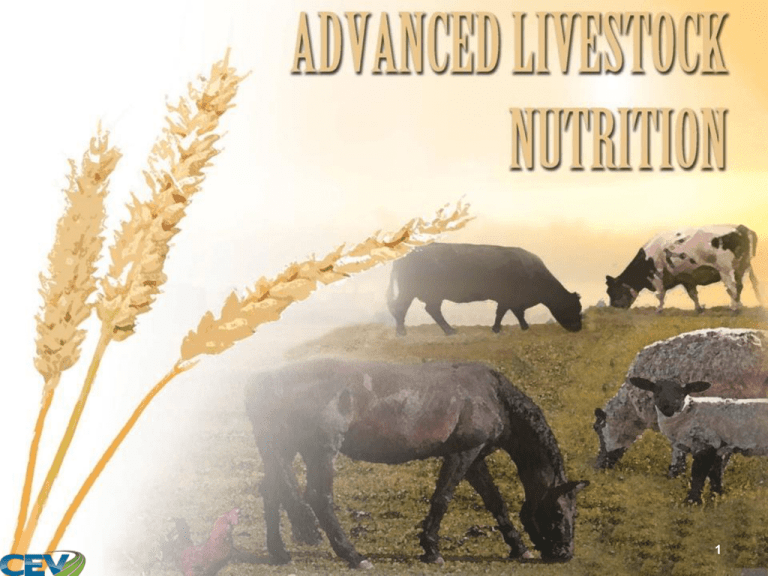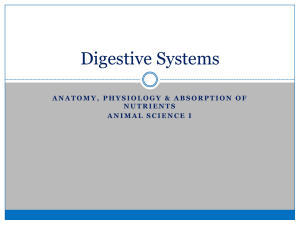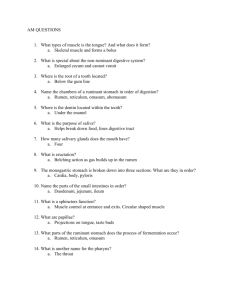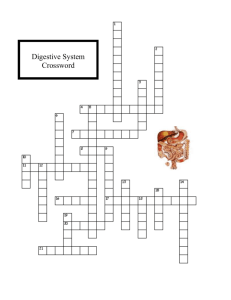Small Intestine - Cloudfront.net
advertisement

1 1. To identify structures and functions of the digestive system of ruminant and non-ruminant animals. 2. To identify and describe vitamins, minerals and additives in livestock feed. 3. To analyze feeding rations, principles and practices based on nutritional requirements of livestock animals. 4. To explore livestock feed quality issues and determine the effect on animal health. 2 1. Digestive Systems of Ruminant and Non-Ruminant Animals 2. Nutrients, Vitamins, Minerals and Additives in Livestock Feed 3. Livestock Feed and Feedstuff 4. Rations, Quality and Feeding Practices of Livestock Animals 3 4 • • • • Breaks down feed into smaller molecules of nutrients Absorbs the nutrients used by the body for energy Is achieved by both chemical and physical means Is made up of the Gastrointestinal Tract (GIT), which extends from the mouth to the anus Fun Fact: Parts of food which cannot be broken down, digested or absorbed are excreted as bowel movements.5 • Functions : to break down feed particles (proteins, fats and starches) into smaller molecules (amino acids, fatty acids and glucose) to absorb the molecules produced by digestion into the circulatory system for distribution around the body to eliminate the undigested and unabsorbed feed 6 • Is separated into the following three steps: mechanical forces chemical action hydrolysis of ingesta 7 • Is the way animals gather the food into their mouths horses use their lips cows use their tongues sheep and goats use both tongue and lips chickens use their beak and gravity to throw food to the back of their throats and swallow 8 • • • • Is where food enters the digestive tract Reduces size of food particles by grinding or chewing Is the place of mechanical breakdown (mastication) Is the start of enzymatic breakdown (saliva is added and contains enzymes which break down feed) • Mixes food with saliva to create a bolus Bolus - a mass of food and saliva formed in the mouth after 9 thorough chewing • Is also known as chewing • Breaks down the particle size to increase surface area, allows enzymes and chemicals to more readily break down nutrients • Is a repetitive sequence of the jaw opening and closing, known as the chewing cycle Fun Fact: Ruminant animals chew food more than once to 10 extract more nutrients. • Is the muscular tube which takes food from the mouth to the stomach • Consists of peristalsis muscle contracting to push the food toward the stomach • Also contains cardiac valve, which prevents food from passing from the stomach back into the esophagus Esophagus 11 • Are animals with a multi compartment stomach • Spend about eight hours a day grazing, eight hours a day ruminating and eight hours a day resting • Are often called “cud chewers” • Have the unique ability to break down very fibrous feedstuffs (cellulose) • Have no upper incisors have a harden gum called a “dental pad” Examples: cattle, sheep, goats, buffalo and deer Fun Fact: Ruminants eat fibrous feed and later regurgitate 12 the material, called the cud, and chew it again. • Include the following: rumen reticulum omasum abomasum 13 • Allows the ruminants to digest celluse • Is the first of three stomachs which make up the forestomach • The food is mixed with fluid to form a soft mass – the cud – or bolus • Is the largest of the four compartments • Acts as a storage or holding vat for feed Rumen 14 • Contains anaerobic bacteria to initiate breakdown of cellulose • Functions include: location where the plant material is broken down fermentation of protein and carbohydrates Rumen 15 • Are microorganisms which continually eat away at the rumen contents to help decrease particle size, which will increase absorption ruminants depend on rumen microbes to convert feed components into useable sources of energy and protein the number and proliferation of microbes depends on the rumen pH and the supply of energy and protein bacteria and protozoa are the most important microbes and they digest approximately 70 to 80 percent of digestible dry matter 16 • Is separated from the rumen by a ridge of tissue • Is made up of a tough lining to catch foreign material which might have been present in the feed • Also known as the honeycomb because the lining resembles a honeycomb • Works with the rumen to provide an additional area for fermentation Reticulum Enzymes - proteins which increase the rate of chemical 17 reactions • Is the third division of the forestomach • Is located between the reticulum and the abomasum • Acts as a type of pump which moves the food from the reticulorumen to the true stomach • Can also be known as the manyplies • Contents are about 90 to 95 percent water Omasum Fun Fact: The omasum is sometimes referred to as “the 18 butcher’s bible” because of its similarity to pages of a book. • Functions include: removal of water further grind and break down of feed contain plate-like folds known as laminae which extend from the wall of the omasum, like pages in a book extend from the binding the laminae are covered with papillae which control the directional flow of particles to the abomasum Omasum 19 • Connects omasum to small intestines • Is the ruminant's true stomach and is very similar to the stomach of monogastrics • Almost always contains a continuous flow of food because of the large amount of food eaten • Utilizes acid digestion instead of microbial fermentation like rumen lining contains folds which produce gastric juices containing enzymes (pepsins) and hydrochloric acid Abomasum 20 • Have one stomach (mono: one, gastric: stomach) • Are usually carnivores or omnivores • Usually eat small quantities of forage or fiber • Have a simple stomach similar to humans Examples: horses, poultry and swine 21 • Is a sack-like organ lined with a glandular, absorptive mucosa • Is involved in the second phase of digestion • Secretes pepsin and hydrochloric acid to break down food particles Stomach Fun Fact: A horse’s stomach contains less than ten percent 22 of the GI tract. • Is divided into the following four sections: cardia (entrance) fundus (left portion of the stomach) body (main portion of the stomach) pylorus (termination) Stomach 23 • Is the portion of the digestive tract between the stomach and anus • Is the longest section of the digestive system • Is the location where most chemical digestion takes place • Is the location where most of the nutrients in food are digested • Is where most food products are absorbed Small Intestine 24 • Is divided into three sections: duodenum jejunum Duodenum Jejunum ileum Ileum Small Intestine 25 • Is the first section of the small intestine • Mixes chyme with digestive fluids from the gallbladder (bile) and pancreas (pancreatic juices) • Is the location where most chemical digestion takes place Duodenum Chyme - the partially digested mass of food from the stomach 26 • Is the long, coiled mid-section of the small intestine • Is the location where breakdown of the chyme is completed • Is lined with villi Jejunum Villi - small, finger-like outgrowths which make it easier for 27 digested material to be absorbed • Is the final section of the small intestine • Is the site of absorption of vitamin B • Also absorbs bile salts and products not absorbed by the jejunum Ileum 28 • Includes: both exocrine and endocrine functions endocrine glands do not have ducts, therefore release hormones into the interstitial spaces surrounding the cells exocrine glands secrete substances through ducts and discharge them into the external environment, organs or outside the body Pancreas 29 • Produces enzymes to aid in the break down of carbohydrates, fats, proteins and acids in the duodenum • Produces two hormones to help regulate blood: insulin glucagon Pancreas 30 • Is the largest gland in the body • Stores vitamins, iron and glycogen • Detoxifies chemicals, pollutants and poisons • Connected to gallbladder (except in horses) • Is the place bile is stored Liver Bile - a thick greenish-yellow digestive fluid, aids in the 31 digestion of fats • Main function is removal of water from food waste • Compresses waste into a form easier for expulsion from the body • Mixes chyme with mucus and bacteria, converts to feces • Is shorter than small intestine, but larger in diameter • Varies from species to species Large Intestine 32 • Consists of: cecum colon rectum anus Cecum Rectum Colon Anus Large Intestine 33 • Also known as the blind gut • Is the main place for fiber digestion in horses • Utilizes hind-gut fermentation which mainly takes place in their oversized cecum • Is similar to the cow’s rumen • Breaks down feed not digested in the small intestine • Is the beginning of the large intestine Cecum 34 • Extracts water and salt from waste before it is extracted from the body • Does not play a major role in the absorption of nutrients and foods Colon • Includes: ascending colon transverse colon descending colon sigmoid colon 35 • Is the terminal portion of the large intestine • Stores solid waste (feces) • Is the area used in some animals for entry during artificial insemination Rectum Fun Fact: Large animals, specifically cattle, when being artificially inseminated will have one hand placed into the rectum to locate the cervix to feed the A.I. rod through the 36 cervix to the uterus. 36 • Is the last part of the digestive tract • Is the opening for undigested food to pass from the body • Controls the extraction of feces Anus 37 Small Intestine Rectum Duodenum Esophagus Pancreas Rumen Colon Anus Recticulum Omasum Abomasum Liver Villi Large Intestine Gall Bladder 38 Esophagus Jejunum Duodenum Ileum Pancreas Colon Anus Rectum Stomach Liver Villi Cecum Large Intestine Gall Bladder Small Intestine 39 Esophagus Large Intestine Rumen Small Intestine Cecum Anus Reticulum Omasum Abomasum Duodenum 40 Esophagus Rumen Cecum Large Intestine Anus Reticulum Omasum Small Intestine 41 Proventriculus Liver Small Intestine Cloaca Pancreas Esophagus Anus Crop Ceca Spleen Gizzard Duodenum Large Intestine 42 Esophagus Stomach Cecum Anus Duodenum Small Intestine Large Intestine 43 44 • Can also be termed nourishment or aliment • Is the step involved in absorption of feed by the body, utilized for maintenance (normal function), reproduction and growth • Aids in preventing disease and promoting health 45 • Are substances or chemical compounds required by the animal for productive purposes • Are essential for life and required for diet • Build and repair tissues, give heat and energy, and regulate body processes Diet - a mixture of the feedstuffs available for the animal to 46 provide the nutrients • Include: proteins carbohydrates lipids (fat) vitamins minerals water 47 • Are composed of 20 amino acids ten can be synthesized by tissue in the body – non-essential amino acids ten must be provided in the diet – essential amino acids • Can be calculated by multiplying percentage of nitrogen by 6.25 Amino Acids - organic compounds containing an amino 48 group and a carboxylic acid group • Are composed only of carbon, hydrogen and oxygen • Are the main source of energy • Comprise 65 to 75 percent of dry weight in grains, forages and roughages 49 • Are made up of: simple carbohydrates (sugars) quickly digested quick source of energy contain refined sugars and few essential vitamins and minerals complex carbohydrates (starches) require longer to digest usually packed with fiber, vitamins and minerals 50 • Are used as energy • Are broken down into two types fats – typically of animal origin (saturated fatty acids and are solid at room temperature) oils – typically of plant or marine origin (unsaturated fatty acids and are liquid at room temperature) • Are composed of glycerol esterified to three fatty acid molecules • Fatty acids can vary in length and saturation saturation – is the presence of double bonds saturated fatty acids – have no double bonds unsaturated fatty acids – have one or more double bonds 51 • Are present in food and required by the body in small amounts • Regulate metabolism and maintenance for normal growth and functioning • Are most common in the forms of : A, D, E, K vitamins (fat soluble) B, C vitamins (water soluble) 52 • Are stored in body fat • Are also stored in the liver when not in use • Taken in excess can be harmful, as they do not readily leave the body 53 • Can be dissolved in water • Are not stored in the body and must be replenished daily • Contain little health concern if excessive amounts are consumed 54 • Aids in releasing energy from carbohydrates • Helps with nerve function • Plays a key role in glucose metabolism • Requirements are influenced by animal size, genetic factors and physiological status 55 • Is required for normal cell activity to occur • Is required for maturation of red blood cells • Is more important in a ruminant than in a non-ruminant • Involved in carbohydrate and fat metabolism, helps with protein synthesis • Is mainly stored in the liver 56 • Is found only in animals • Aids in an animal’s vision and night vision • Is essential for proper kidney function • Is also used for development of bones, teeth and nerve tissue • Helps maintain a healthy immune system • Is mostly (90 percent) stored in the liver 57 • Is formed by the presence of sunlight upon certain sterols • Promotes growth and maintenance of bones and teeth • Aids in regulation of blood calcium levels • Increases the absorption from the digestive tract and metabolic use of phosphorus and calcium • Is stored mainly in the blood 58 • Is made by bacteria in the rumen • Is essential in the liver for the production of prothrombin • Is required for the synthesis of plasma clotting factors 59 • Are needed for digestion to form skeletal structures and in metabolic processes within the body • Aid in formation of muscles, tissues and bones • Are broken down into two types: macrominerals - calcium, phosphorus and salts (required in large amounts) microminerals - zinc and selenium (required in small amounts) 60 • Macrominerals (major minerals) are required in large quantities • Microminerals (trace minerals) are required in smaller quantities • Can be added to the feed directly or in the form of mineral blocks trace mineral block (red) salt block (white) salt plus sulfur (yellow) 61 • Are generally acquired with consumption of forages, especially legumes • Play an important role in muscle function • Are responsible for development and maintenance of the skeletal system • 98 to 99 percent (calcium) is stored in bones • Plays a role is synoptic nerve transmission Ca:P ration in bones are 2:1 Ca:P ration in muscles is 1:2 62 • Is present in enzymes, protein, certain vitamins and other compounds • Is found in high levels in soybean products, alfalfa hay and corn byproducts • Can also be found in water • Is needed for hemoglobin function • Is a crucial mineral for wool and feather growth 63 • Work together to maintain cellular volume, pH and water balance of body fluids • Are commonly expressed as a salt requirement • Are involved in muscle and nerve function • Regulate cation and anion equilibrium • Assist in transport of amino acids, minerals and vitamins into cells (Sodium) 64 • Is needed to maintain normal body and organ function • Helps to transport nutrients in and out of cells • Helps with water balance, active transport of nutrients into the cell and nerve transmission • Assists in regulating heartbeat 65 • Is required for synthesis of vitamin B-12 • Can also act as a substitute for zinc in the large intestine • Must be consumed in the animal’s diet • Must be supplemented to monogastric animals • Can be supplied by rumen organisms 66 • Is required in very low levels • Is essential for production of thyroxin • Is extremely important in diet of pregnant animals to ensure normal development of fetus • Supplement is commonly iodized salt • Deficiency and toxicity can cause Goiter Thyroxin - a hormone which regulates metabolic rate 67 • Plays an important role in growth and reproduction • Functions as a part of the numerous enzyme systems • Vary depending on the stage of production • Supplementation is needed in poultry and cattle 68 • Plays an important role in DNA, RNA and protein production • Plays a role in immune response, hoof health and enzyme systems • Is contained in forages, grains and proteins • Is stored in liver and bones • Is important for skin and wound healing 69 • Is the most important nutrient • Helps to regulate body temperature • Aids in transporting nutrients throughout the body • Rids the body of waste materials • Makes up more than 50 percent of the blood system Fun Fact: Two to five pounds of water will be consumed for 70 every pound of feed consumed by the animal. • Can be accessed by an animal from: tank or pond bowl waterer automatic waterer nipple waterer (swine) Fun Fact: Nipple waterers used for swine are healthier with 71 a lower risk of bacteria unlike with pools and tanks. • Purposes: preserve flavor improve taste and appearance supply medication • Provide no nutrition, although some are added for extra vitamins and minerals • Are important in young animals’ diets (flavoring compounds) as they learn to eat dry feed rather than milk from mother 72 • Ruminants microbial additive development of rumen microflora increase feed intake acid additive feed preservative silage additive prevention of ketosis milk replacer 73 • Non-Ruminants probiotics prevention of intestinal disease enzyme additive improves digestibility of poor-quality feed amino acids fermentation chemical synthesis 74 75 • Include: dry: hay, grains, oilseed, straw, corn husks, soybeans and hulls cereal grains, cotton seed meal/hulls green: pasture and green chop high moisture: haylage, wet byproduct feeds, roots, tubers and silages Feed - grains and byproducts eaten by the animal 76 • Four primary purposes in livestock feeding: to improve palatability to alter the particle size to improve digestibility to facilitate preservation, storage or transportation of the grain 77 • Grinding • Dry rolling, cracking, crimping • Pelleting • Steam rolling • Steam flaking 78 • Is usually done with a hammer mill • Grinds the grain to a very small particle size which drastically increase surface area and rate of digestion • Is a common process for swine and poultry feeds • Is not common in beef cattle because it decreases palatability and increases the potential for ruminal acidosis (bloat) 79 • Is done by passing grain through a set of grooved (corrugated) rolls • Particle size can vary from fine to coarse • Is not frequently used for swine or poultry • Is common for beef and dairy cattle 80 • Is ground or cracked grain before being steamed and forced through a pellet mill • Increases product density and decreases fine particles which typically decreases wastage • Makes grains easier to store and transport 81 • Is commonly used in poultry and swine and has been shown to increase their weight gain and feed efficiency • Is not cost effective to use in a beef feedlot or on dairy cattle • Is a common way to supplement protein and/or energy to range cows and horses (i.e. range cubes) 82 • Grain is exposed to steam one to eight minutes before rolling • Process can also be known as crimping or steam crimping • Particle size and physical form of crimped grain may improve palatability and animal acceptance in some instances • Offers little to no advantage in feed efficiency over grinding or rolling 83 • Grain is steamed for 15 to 30 minutes and then rolled to produce a thin flake • Starch digestibility is increased because of extensive gelatinization and rupture of the starch granules • For corn, feed efficiency is improved seven to ten percent versus dry rolling or cracking methods • Steam flaking is the most common processing method utilized in the feedlot industry 84 • Is defined as feed for livestock • Refers to food given to the animals, rather than food they forage for themselves • Includes: hay straw feeds sprouted grains legumes 85 • Most common and abundant cereal grain • High in energy but has a low protein level eight to ten percent • Often used because of cost efficiency 86 • Is the most important protein supplement for livestock feeding in the United States • Contains 44 to 50 percent protein • Has a good balance of amino acids suitable for feeding swine and poultry • Is the product remaining after extracting most of the oil from whole soybeans 87 • Is the second most important livestock protein supplement in the United States • Has a lower palatability than soybean meal, especially for non-ruminants • Contains approximately 44 percent crude protein content and 12 percent crude fiber Fun Fact: Cottonseed hulls are commonly fed to cattle on 88 an as-is basis. • Is produced in areas where water is not available for corn to survive • Has hard seed coat which must be processed to improve the nutrients available to the animals • Has a relatively low quality protein • Contains 8 to 12 percent crude protein Crude protein - an estimate of the total protein of a feed includes nitrogen containing substances such as ammonia, 89 amino acids and nitrates • Is a popular cereal grain but is generally too expensive • Protein is superior to corn and grain sorghum • Grows in many areas, used for grazing and grain soft wheat from the western United States: 10 to 11 percent protein hard red winter wheat of the United States Great Plains: 12 to 14 percent protein 90 • Possess the highest quality protein of all the cereal grains 13 to 14 percent • Contain a large hull which is less digestible, but usually removed when processed • Are an ideal grain for starting cattle on feed because of its high fiber and hull content • Causes less colic compared to other grains in horses Hull - the outer covering of a seed or fruit 91 • Is commonly used in diets of feedlot cattle • Is also a strong component of horse feed • Contains water-soluble carbohydrates which are poorly digested and lower its energy content • Outside hull makes it less digestible than corn, wheat or milo • Contains 12 to 13 percent crude protein content 92 • Is primarily grown for grain, but occasionally for hay or pasture • Has a fairly bitter taste • Is normally mixed with other grains • Contains 12 to 13 percent crude protein content 93 • Is a crop species resulting from a plant breeder's mix between wheat and rye • Is used mainly as a hay source • Is more palatable than rye 94 • Is cut, dried and baled grass • Is high in fibrous materials and contains a lot of carbohydrates • Is used with inadequate availability of rangeland or pasture due to weather • Is also used if animal is unable to access pastures, such as animals kept in a stable or barn • Nutritional value will vary greatly between hay type, time of harvest and storage Fun Fact: Protein content can be determined by the stage of growth of the plants at time of harvest. The more immature the plants are when harvested, the higher the 95 protein content. • Common grasses include: fescue Bermuda grass brome grass matua coastal sorghum alfalfa 96 • Are used for their high protein content, roughly 18 percent protein • Are used in pastures to be grazed or cut for hay • Include: alfalfa clovers vetches 97 • Are blended from various raw materials and additives • Are formulated according to the specific requirements of the target animal • Contain a complete diet in each pellet • Differ in size depending on animal size 98 99 • Are a matter of combining feeds • Are effective when consumed at a level to supply an efficient amount of energy in relation to body weight • Are the amount needed to supply the daily nutrient requirements of the animal • Should normally be economical, palatable and free of toxic substances 100 • Can be provided to animals in a number of different ways • Include: feeders range cubes lick tanks for liquid feeds tub feeders protein blocks 101 • Affects its value for animal nutrition • Includes palatability and nutrient content • Is higher if produced on well fertilized soils • Can decline with improper harvesting or handling • Can also decline with extreme in weather hot, cold, wet or dry 102 • Is affected by harvesting and handling methods • Must reduce moisture contents so it can be stored without spoiling or undergoing serious loss of nutrients • Should be baled as soon as possible after it reaches a safe moisture level for storage 103 • Refers to how well the animal will accept feed • Can cause difficulties if animal does not find a feed acceptable • Problems include: animals not eating enough reduced growth and gains low production of meat, milk or eggs increased sickness 104 • Is a subjective measurement of the amount of fat on an animal’s body • Scores cows from 1 (thin) through 9 (fat) 1 (emaciated) 2 (very thin) 3 (thin) 4 (borderline) 5 (moderate) 6 (good) 7 (fleshy) 8 (fat) 9 (extremely fat) 105 • Include: maintenance: 70 to 80 percent gestation: 18 to 20 percent lactation (milk): 6 to 8 percent Fun Fact: Younger animals will also have growth as a percentage of their feed uses. Gestation - the carrying of an embryo or fetus inside a 106 female animal • Include: breed sex body size ruminal capacity body condition grazing time weather 107 1. The muscular tube which takes food from the mouth to the stomach is known as which of the following? A. Ruminant B. Microbes C. Jejunum D. Esophagus 2. Carbohydrates make up what percentage of the dry weight in grass, forages and roughages? A. 65 to 75 B. 35 to 45 C. 5 to 15 D. 75 to 85 108 3. Which vitamin helps with vision and night visions in animals? A. Vitamin D B. Vitamin K C. Vitamin A D. Vitamin B-12 4. Which of the following is the largest and first compartment of a ruminant stomach? A. Aejunum B. Abomasum C. Reticulum D. Rumen 109 5. Which of the following rids the body of waste and transports nutrients through the body? A. Sulfur B. Water C. Vitamins D. Fat 6. Which of the following does NOT consist of fat soluble vitamins? A. Vitamin D B. Vitamin C C. Vitamin A D. Vitamin K 110 7. What type of mineral block is usually a white color? A. Sodium B. Trace C. Calcium D. Salt 8. The desired number wanted in cattle body condition scoring is which of the following? A. Four B. Seven C. Three D. Six 111 9. The repetitive sequence of opening and closing the jaw takes place during which process? A. Mastication B. Prehension C. Digestion D. Reticulum 10. Which of the following minerals plays an important role in DNA and RNA production? A. Potassium B. Iodine C. Zinc D. Manganese 112 Buchanan-Smith, J., Berger, L. L., Calvin, F., Fox, D. G., Galyean, M., Hutcheson, D. P., et al. (1996). Nutrient Requirements of Beef Cattle. Washington, D.C.: National Academy Press. Cromwell, G. L., Baker, D. H., Ewan, R. C., Kornegay, E. T., Lewis, A. J., Pettigrew, J. E., et al. (1998). Nutrient Requirements of Swine. Washington, D.C.: National Academy Press . Hall, J. B., & Silver, S. (2009). Nutrition and Feeding of the Cow-Calf Herd:Digestive System of the Cow. Blacksburg, Virginia : Virginia Polytechnic Institute and State University. 113 Kline, D. R., Porr, D. S., & Cardina, D. J. Horse Nutrition. Columbus, Ohio: Ohio State University Extension . Lalman, D., & McMurphy, C. Vitamin and Mineral Nutrition of Grazing Cattle. Stillwater, Oklahoma: Oklahoma State University,Division of Agricultural Resources and Natural Resources. Linn, J. G., Hutjens, M. F., Shaver, R., Otterby, D. E., Howard, W. T., & Kilmer, L. H. (2002). Feeding the Dairy Herd. St. Paul, Minnesota: University of Minnesota Extension. 114 Myer, R. (2003, September 19). Alternative Feed for Beef Cattle. Retrieved May 15, 2010, from University of Florida-EDIS: http://www.ufl.edu Rounds, W., & Herd, D. B. Texas Agriculture Extension Service. College Station,Texas: Texas A&M University System . Rowan, J., Durrance, K., Combs, G., & Fisher, L. (1997). The Digestive Tract of the Pig. Gainesville, Florida: Animal Science Department, Florida Cooperative Extension Service. Weimer, P. (2007, March). Rumen microbes. Retrieved June 15, 2010, from Fact Sheet:U.S. Dairy Forage Research Center: http://www.ars.usda.gov 115 Production Coordinator: Daniel Johnson Collaborator: Bryan Bernhard, M.S., Texas Tech University Project Coordinator: Production Manager: Meghan Blanek Williams Maggie Bigham Graphic Designer: Executive Producers: Daniel Johnson Gordon Davis, Ph.D., Jeff Lansdell © MMXI CEV Multimedia, Ltd. 116








